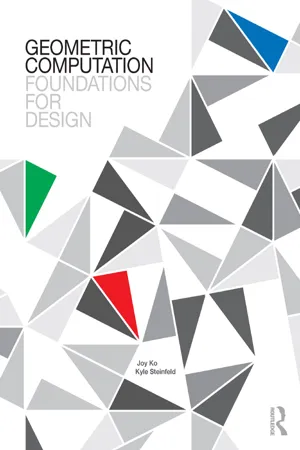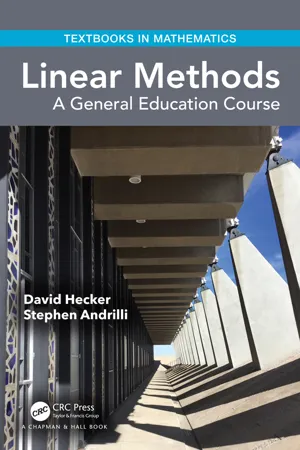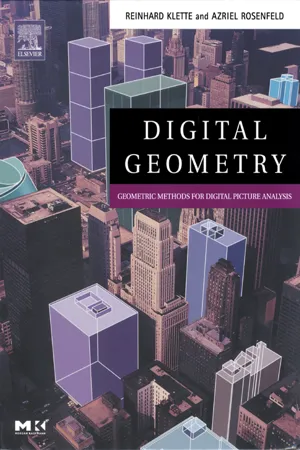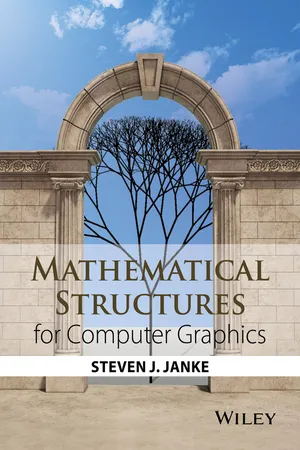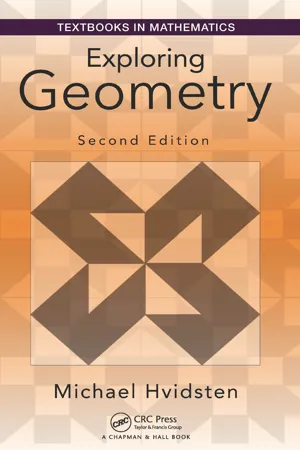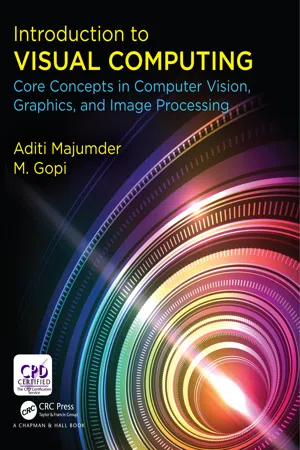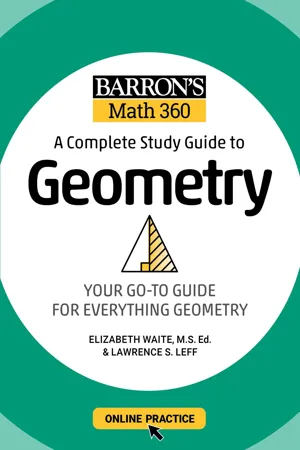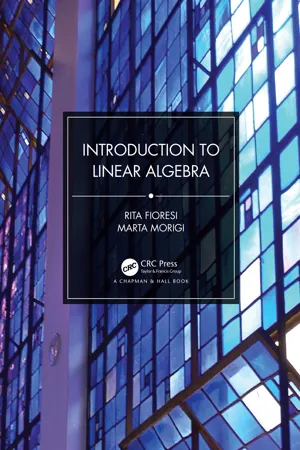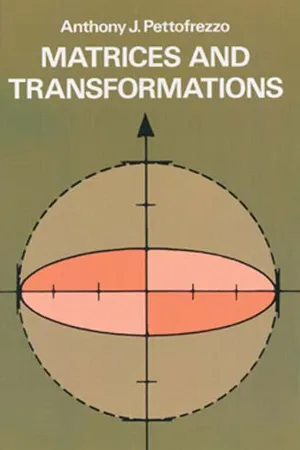Mathematics
Transformations
In mathematics, transformations refer to the process of changing the position, size, or shape of a geometric figure. Common types of transformations include translations, rotations, reflections, and dilations. These transformations are used to study the properties and relationships of geometric shapes and patterns.
Written by Perlego with AI-assistance
Related key terms
Related key terms
1 of 4
Related key terms
1 of 3
12 Key excerpts on "Transformations"
- eBook - ePub
Linear Algebra
An Inquiry-Based Approach
- Jeff Suzuki(Author)
- 2021(Publication Date)
- CRC Press(Publisher)
3Transformations
3.1 Geometric Transformations
An important concept in mathematics is that of a transformation, where we take some object and alter it to produce a new object. The most familiar type of transformation is a geometric transformation. We can look at these Transformations in two ways:- Geometrically: We reflect a point across an axis, or rotate it about a center of rotation, or translate it some distance horizontally and vertically,
- Algebraically: We take the coordinates of the point( x , y )and alter them to produce a new set of coordinates for the point(.x ′,y ′)
In either case, we say that the new point is the image of the original under the transformation. Additionally, we might say the original point is the preimage of the transformed point.One way to view the transformation is as a set of functions, where the new coordinates(are functions of the old coordinates,x ′,y ′)x ′= f ( x , y )y ′= g ( x , y )wheref ( x , y )andg ( x , y )are some formulas that involve x and y.Example 3.1. Consider a translation that shifts every point 3 units to the right. Express the new coordinates(in terms of the old coordinatesx ′,y ′)( x , y ).Solution. Let’s draw a picture showing how a generic point with coordinates( x , y )is affected by this translation:Since the point has been shifted 3 units to the right, the new x-coordinate must be 3 more than the original:x ′= x + 3But since the point has not been shifted up or down, the new y-coordinate is the same as the original:y ′= yActivity 3.1: Geometric TransformationsA3.1.1 For each transformation given, find formulas that compute the new coordinates(from the original coordinatex ′,y ′)( x , y ).- Mx, the reflection of a point across the x
- eBook - ePub
- Joy Ko, Kyle Steinfeld(Authors)
- 2018(Publication Date)
- Routledge(Publisher)
The challenges of this simple scenario are indicative of those we will confront in this chapter, and also hint at their different resolutions: Transformations will test our competency in math, while intersections relies on structures in code. A grasp of the versatile transformation matrix, a unifying representation that is capable of describing a wide range of Transformations, requires a deeper discussion of the underlying mathematics. To understand how the action of intersecting any two arbitrary pieces of geometry can be represented by an object - a machine for intersecting - will also demand that we broaden our conception of the nature of an object in code.fig 1.236 MIRROR TRANSFORMATIONConstruction using compass and straightedge.TRANSFORMATION MATHEMATICSAs experienced users of CAD software, we are sure to be familiar with a set of operations designated by verbs, such as “Move”, “Mirror”, “Rotate”, and “Scale”, and that act upon a geometric object to produce the same kind of object, only transformed. Operations such as these are termed Transformations or transforms. After an object has undergone a transformation, we can observe that certain properties of the object are altered while others are preserved. Mathematicians employ a number of terms (such as congruency, isometry, similarity, and affinity) to classify Transformations by the features they preserve and those they distort. In addition to the previously mentioned transforms, we will no doubt also be familiar with another sort of operation in CAD: projections - eBook - ePub
Linear Methods
A General Education Course
- David Hecker, Stephen Andrilli(Authors)
- 2018(Publication Date)
- Chapman and Hall/CRC(Publisher)
• Geometric transformation: A transformation of the plane whose movement of points can be described geometrically. Rotations, reflections, scalings, and translations are examples of geometric Transformations.• Image: The resulting point (or vector) obtained from a given point (or vector) from a transformation of the plane.• Matrix transformation of the plane: A movement of the points in the plane obtained by matrix multiplication.• Preserving angles: A transformation of the plane preserves angles if the angle between all pairs of line segments that share a common endpoint is the same as the angle between their images. Similarities preserve angles.• Preserving distances: A transformation of the plane preserves distances if the distance between any pair of points in the plane equals the distance between their images. Rotations, reflections, and translations all preserve distances. Any matrix transformation that preserves distances also preserves angles. (See Exercise 13.)• Reflection about a line: A transformation of the plane in which the image of each point in the plane is on the opposite side of the line of reflection, the segment connecting a point and its image is perpendicular to the line of reflection, and that segment has its midpoint on the line of reflection. Points on the line of reflection remain fixed.• Reflection through a point: A scaling with scaling factor −1. (See Exercise 8 in this section, and Exercises 3(a) and 4(d) in Section 7.3 .)• Rotation: A transformation of the plane in which every point is rotated by the same angle about a fixed point. Unless stated otherwise, rotations are assumed to be counterclockwise.• Scaling: A transformation of the plane that multiplies every vector by the same scalar c.• Scaling factor: The scalar used in a scaling transformation.• Similarity: A transformation of the plane that preserves angles. Scalings, rotations, reflections, and translations are all similarities.• - eBook - ePub
Digital Geometry
Geometric Methods for Digital Picture Analysis
- Reinhard Klette, Azriel Rosenfeld(Authors)
- 2004(Publication Date)
- Morgan Kaufmann(Publisher)
CHAPTER 14Transformations
Subfields of geometry are sometimes defined by systems of axioms and sometimes by groups of Transformations under which certain geometric properties remain invariant. This chapter describes the transformation-based approach and presents a set of axioms for digital geometry. It discusses transformation groups and symmetries, neighborhood-preserving Transformations, applying Transformations to pictures, magnification and demagnification, and digital tomography.14.1 Geometries
A wide variety of geometries have been developed, motivated by a wide variety of applications: Euclidean (Thales of Miletus, Hippocrates of Chios, the secret society of the Pythagoreans, Euclid, Archimedes); analytic (Descartes, also known as Cartesius); perspective (Alberti, da Vinci, della Francesca, Dürer); projective (Desargues, Pascal); descriptive (Monge); non -Euclidean , such as elliptic and hyperbolic (Lobachevsky, Bólyai, Riemann); and combinatorial (Helly, Borsuk, Erdõs).The Norwegian mathematician S. Lie and the German mathematician F. Klein formulated a classification system for all of the geometries known at their time:Geometric properties of objects are those which are invariant with respect to a specified group of Transformations.This classification scheme is known as the 1872 Erlangener Programm of F. Klein. Let B be a base set and G a group of Transformations defined on B . The theory of invariants with respect to B and G , which studies quantities that can be measured in B that have values that are invariant under the Transformations in G , defines a geometry in which a nonempty family of subsets (“objects” or “figures”) F ⊆ ℘(B - eBook - ePub
- Steven J. Janke(Author)
- 2014(Publication Date)
- Wiley(Publisher)
Once we have the list of triangles and associated vertices representing the car, we still need to position it in any broader scene; there may well be many other objects. This requires another transformation which will alter all the car's vertex coordinates once again. Finally, when we view the scene, we need to decide where the camera (or our eye) is and in which direction we are looking. This, too, requires another transformation plus a special one to convert our three-dimensional scene into a two-dimensional display. There is no escaping being adept at choosing and applying Transformations.Technically, a transformation is just a function that sends each point (or vertex), , to another point called . The result is to transform an object into a new object. The new object may have the same shape as the old and just a new position, or it may have an altered shape. Before we can talk about the mechanics of actually performing a transformation, we need to once again consider the differences between vectors and points in order to be careful about how we deal with each. Recall that we decided to represent both vectors and points as a column of numbers, soThe vector, however, is a displacement and the point is a position in the plane. We know there is a connection between the two because we determine a vector by subtracting two points. We are most interested in thinking of Transformations as moving points to points, but we can also think of them as acting on vectors. By singling out a point, say the origin , every point can be thought of as a vector from to . Then, if the transformation is reasonably behaved, moving point to is analogous to moving the vector to a vector from to .To transform vectors, we can change their direction and length in various ways. It does not, however, make sense to translate them (move to a new position) because vectors are independent of position. In contrast, it does make sense to translate points by moving them to new positions. It also makes sense to transform points in a way that changes their direction or distance from the origin. To differentiate further between these cases, we call our complete collection of points an affine space and any associated Transformations affine Transformations. Then the collection of vectors formed by taking the difference of any two points is called the associated vector space - eBook - ePub
- Michael Hvidsten(Author)
- 2016(Publication Date)
- Chapman and Hall/CRC(Publisher)
CHAPTER 5Transformational Geometry
Geometry is the study of those properties of a set which are preserved under a group of Transformations on that set. – Felix Klein (1849–1925)Classical Euclidean geometry, such as the material covered in Chapter 2 , is primarily concerned with static properties of objects. To expand this static geometry to a more dynamic geometry, we need to explore what it means to transform objects.A transformation will be some function on points in the plane. That is, it will be some process whereby points are transformed to other points. This process could be the simple movement of points or could be a more complex alteration of the points.Transformations are basic to both a practical and theoretical understanding of geometry. Object permanence, the idea that we can move an object to a different position, but the object itself remains the same, is one of the first ideas that we learn as infants.Felix Klein, one of the great geometers of the late nineteenth century, gave an address at Erlanger, Germany, in 1872, in which he proposed that geometry should be defined as the study of Transformations and of the objects that Transformations leave unchanged, or invariant . This view has come to be known as the Erlanger Program - eBook - ePub
Introduction to Visual Computing
Core Concepts in Computer Vision, Graphics, and Image Processing
- Aditi Majumder, M. Gopi(Authors)
- 2018(Publication Date)
- CRC Press(Publisher)
6Geometric Transformations
Geometric transformation, in general, means transforming a geometric entity (e.g. point, line, object) to another. This can happen in any dimension. For example, a 2D image can be transformed to another by translating it or scaling it or applying a unique transformation to each of its pixels. Or, a 3D object like a cube can be transformed into a parallelepiped or sphere. All of these will be considered as geometric Transformations. Often a 2D image transformation is also called an image warp .6.1 Homogeneous CoordinatesBefore we start with geometric Transformations, we will first introduce a very important concept of homogeneous coordinates. Let us consider the very simple case of the 1D world (see the red line in Figure 6.1 1eft). Let us consider a point P ’ on this line. The coordinate of this point will be one dimensional. Let it be (p ) . Now consider a higher dimensional 2D world in which this line is embedded at y = 1. Draw a ray from the origin of this world through the point P ’ . Consider a pointon this line. Now, find out what would be the coordinate of P ’ in the 1D world of the red line when expressed using x and y . Using similar triangles you can see thatP ( x , y ). Further, any point on this ray from the origin can be expressed as (kx , ky ) where k ≠ 0, and the value of p is invariant to the location of P on this ray.p =x yFigure 6.1 . Homogeneous coordinates in 1D (left) and in 2D (right).Therefore, a point in the 1D world, such as P ’ , when embedded in 2D , can be thought of as the projection of all points on a ray in the 2D world and the 2D coordinate of the projection is given by. Thus, any point in 1D can be considered as the projection of a ray in the 2D world on to a specific 1D world, in this case, the world of y = 1. This is called the (n + 1)D homogeneous coordinate of a n dimensional point. Therefore,(x y, 1 )is the 2D homogeneous coordinate of the 1D point P ’ . Also,(x y, 1 )refers to the same ray but the projection is now on the y = k( kx y, k ) - Lawrence S. Leff, Elizabeth Waite(Authors)
- 2021(Publication Date)
- Barrons Educational Services(Publisher)
8 TRANSFORMATION GEOMETRYWHAT YOU WILL LEARN
In this chapter you will learn: •that a geometric transformation may change the position, orientation, or size of an object; •Transformations may produce images that are congruent or similar to the original figure; •different types of symmetry; •how to apply Transformations using coordinates; •the single Transformations that are equivalent to performing consecutive reflections either over two parallel lines or over two intersecting lines.SECTIONS IN THIS CHAPTER•Terms and Notation•Congruence Transformations•Classifying Isometries•Size Transformations•Types of Symmetry•Transformations in the Coordinate Plane•Composing Transformations•Congruence Proofs Using TransformationsTerms and Notation
ONE-TO-ONE MAPPINGS
A mapping between two sets is a pairing of their elements. Suppose the members of set X are three married women, and the three members of set Y are their husbands:Matching each wife with her husband, as inrepresents a one-to-one mapping between sets X and Y, as each woman is paired with exactly one man and each man is paired with exactly one woman.DEFINITION OF ONE-TO-ONE MAPPING
A mapping between sets X and Y is a one-to-one (1–1) function if each element of set X is paired with exactly one element of set Y and if each element of set Y is matched with exactly one element of set X. Pairs of elements that are matched together are corresponding elements.Transformations
Figure 8.1 shows one possible transformation of ΔABC. Triangle A′B′C′, called the image of ΔABC, is determined by using some rule that tells how to map the points of ΔABC onto it.FIGURE 8.1Transformation of ΔABC onto ΔA′B′C′.DEFINITION OF TRANSFORMATION
A transformation is a one-to-one mapping (function) between the elements of two sets where the elements are points. Under a transformation, each point of an object is mapped onto exactly one point called its image. Each image point corresponds to exactly one point of the original object called the preimage- eBook - ePub
- Walter Meyer(Author)
- 2022(Publication Date)
- Chapman and Hall/CRC(Publisher)
6 Transformation Geometry II: Isometries and MatricesDOI: 10.1201/9780429198328-6It would be hard to name a more important aspect of the physical world than that things move and wind up in new positions. Many of the applications of this chapter—in robotics, computer graphics, CAD/CAM—deal with objects in various positions. The underlying mathematics that deals with this is often the same as in Chapter 4 , but now we want to compute locations numerically. This means we will think of points as position vectors, with numerical components, and we will work out formulas and matrices for isometries.Prerequisites:We assume the following ideas about isometries in the plane (all of which can be found in the first three sections of Chapter 4): the definitions of transformation, isometry, and composition; the definition of rotation (including that clockwise rotations have negative angles), translation, reflection, and that an isometry is determined when the images of three given points are known. A little experience with vectors, like the ideas commonly found in third-semester calculus, is needed. The previous chapters can serve as a review, but most of the specific topics of the previous chapters are not needed here. Our use of matrices is fairly elementary, and the reader is only expected to be familiar with multiplication and the associative law for multiplication.Section 1. Equations and Matrices for Familiar Transformations
Changes in the position of an object can often be expressed as rotation, translation, (less often) reflection, or Transformations we have encountered in Section 1 of Chapter 4 (where they were called isometries). Our approach to these isometries is a little different in this chapter: we want to express points in terms of coordinates and isometries with formulas and matrices. We also want to know what matrix operation corresponds to doing one isometry after another, the composition of the isometries in the language of Chapter 4 - eBook - ePub
- Rita Fioresi, Marta Morigi(Authors)
- 2021(Publication Date)
- Chapman and Hall/CRC(Publisher)
CHAPTER 5Linear Transformations
Linear Transformations are functions between vector spaces that preserve their structure, i.e. they are compatible with the operations of sum of vectors and multiplication of a vector by a scalar. As we will see, linear maps are represented very efficiently using matrices. The purpose of this chapter is to introduce the concept of linear transformation and understand how it is possible to uniquely associate a matrix to each linear transformation between ℝnand ℝm, once we fix the canonical bases in both spaces. Then we will study the kernel, the image of a linear transformation and the Rank Nullity Theorem, which is one of the most important results in the theory of vector spaces of finite dimension.5.1 LINEAR Transformations: DEFINITION
In calculus we study the real valued functions. These are laws which associate to a real number, ranging in a certain set called domain of the function, another real number, belonging to another subset of the real numbers, namely the codomain of the function.For example,f : ℝ → ℝ,f ( x ) =is a well-known function from ℝ to ℝ; its graph is the parabola of equationx 2y =. As we know, ℝ is also a vector space, then f is a function between the vector space ℝ (the domain) and vector space ℝ (the codomain). However, this function does not behave well with respect to the vector space structure of ℝ. In fact, if we take two vectors u and v, and we consider the sumx 2u + v, we have immediately thatf ( u + v ) ≠ f ( u ) + f ( v )(if we draw a graph, we see it immediately). In the same way, we can see that the multiplication by a scalar is not preserved. For example, we see thatf ( 2 · 3 ) =.6 2≠ 2 · f ( 3 ) = 2 · 9On the other hand, there are other functionsf : ℝ → ℝ, that behave well with respect to the vector space structure, i.e. they verify the equalitiesf ( u + v ) = f ( u ) + f ( v )andf ( λ v ) = λ f ( v ). Consider for example, the functionf ( x ) = 3 x. We see immediately thatf (and also thatx 1+x 2) = 3 (x 1+x 2) = 3x 1+ 3x 2= f (x 1) + f (x 2)f ( λx 1) = 3 λx 1= λ ( 3x 1) = λ f (x 1) - eBook - ePub
- Anthony J. Pettofrezzo(Author)
- 2012(Publication Date)
- Dover Publications(Publisher)
H of linear homogeneous Transformations.Figure 3-15The set of ordered products of the rigid motion Transformations of the plane may be represented by a matrix of the form where(3-20)Furthermore,(3-21)and(3-22)Two theorems which state that a general linear transformation of the plane is a rigid motion transformation if and only if the matrix representing the transformation satisfies conditions (3-21) and (3-22) will be proved now.Theorem 3-3 Letrepresent a general linear transformation of the plane under which distance is a scalar invariant. Thenanda 11 a 12 + a 21 a 22 = 0.Proof : Consider the points O : (0, 0, 1) and P : (1, 0, 1). Under the transformation represented by T , the image points of O and P are O′: (a 13 , a 23 , 1) and P ’: (a 11 + a 13 , a21 , + a 23 , 1), respectively. Since under the transformation represented by T ,In a similar manner, choosing O : (0, 0, 1) and P : (0, 1, 1), it can be shown thatNow, consider the points O : (0, 0, 1) and P : (1, 1, 1). Under the transformation represented by T , the image points of O and P are O′: (a 13 , a 23 , 1) and P ’: (a 11 + a 12 + a 13 , a 21 + a 22 + a 23 , 1), respectively. Again, since under the transformation represented by T ,Theorem 3-4 Letrepresent a general linear transformation of the plane such that , , and a 11 a 12 + a 21 a 22 = 0. Then distance is a scalar invariant under the transformation represented by T.Proof : Consider any two points P 1 : (x 1 , y 1 , 1) and P 2 : (x 2 , y 2 , 1) on the plane. Under the transformation represented by T, the image points of P 1 and P 2 are (a 11 x 1 + a 12 y 1 + a 13 , a 21 x 1 + a 22 y 1 . + a 23 , 1) and (a 11 x 2 + a 12 y 2 + a 13 , a 21 x 2 + a 22 y 2 + a 23 - Sarah Schuhl, Timothy D. Kanold, Bill Barnes, Darshan M. Jain, Matthew R. Larson, Brittany Mozingo(Authors)
- 2020(Publication Date)
- Solution Tree Press(Publisher)
The next chapter shows examples of a high school geometry unit for Transformations and congruence. Read through the examples to see possible standards teachers expect students to learn next year.Passage contains an image
CHAPTER 4
Geometry Unit: Transformations and Congruence
G eometry students learn to apply theorems, postulates, and definitions to proofs, mathematical problems, and real-world problems as they grow their mathematical reasoning skills. Through your intentional unit design, your geometry team has an opportunity to build student confidence, self-efficacy, and a productive disposition with Transformations (a type of function) and congruence.In eighth grade, students develop an understanding of congruence by experimenting with the properties of rotations, reflections, and translations, also known as rigid motions. Students use physical models, transparencies, coordinate grids, and geometry software to understand that a two-dimensional figure is congruent to another if its preimage can be mapped onto an image using a sequence of rigid motions.In algebra 1, students explore Transformations by analyzing the size, shape, and position effects on the graph of the parent functions for the linear and quadratic functions, f(x) = x and f(x) = x2 , when f(x) is replaced by af(x), f(x) + d, f(x — c), and f(bx) for specific values a, b, c, and d. Next year, in algebra 2, students will analyze effects of Transformations on the graphs of additional parent functions such as exponential, rational, radical, logarithmic, and trigonometric functions.Understanding what students have learned in eighth grade and algebra 1, as well as what they will learn in algebra 2, helps frame the learning needed in geometry as part of the greater story arc for student learning in high school mathematics.In geometry, students use their experiences with geometric Transformations to develop formal proofs for congruence. Students represent and perform Transformations in a plane using various tools, describe Transformations as functions with ordered pairs for domain and range, and compare Transformations that preserve distance and angle to those that do not. Students then use the definition of congruence in terms of rigid motion to decide and explain if two shapes are congruent. Additionally, students explain how the criteria for triangle congruence (ASA, SAS, SSS, AAS, and HL) follow from the definition of congruence preserved by rigid motions.
Index pages curate the most relevant extracts from our library of academic textbooks. They’ve been created using an in-house natural language model (NLM), each adding context and meaning to key research topics.
Explore more topic indexes
Explore more topic indexes
1 of 6
Explore more topic indexes
1 of 4

